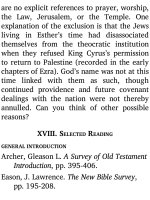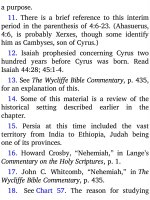Jensens survey of the old testament adam 416
Bạn đang xem bản rút gọn của tài liệu. Xem và tải ngay bản đầy đủ của tài liệu tại đây (131.3 KB, 4 trang )
the background in John’s gospel during
these chapters, but all references to them
reveal a loyal group of followers. (Judas was
the exception.)
Throughout this period of con ict with
His enemies, Jesus faithfully performed His
mission. He told who He was, He
demonstrated who He was, and He invited
all people to believe on Him to be saved.
When that mission was over, He “no longer
continued to walk publicly among the Jews”
(11:54), for He was ready now to
accomplish a more private ministry to the
twelve disciples.
The climax of opposition came in the hour
of cruci xion, recorded by John in chapter
19. The antagonism of the rulers and people
against Jesus during these last two years of
His public ministry was incessant. Even
some of Jesus’ disciples opposed Him on
occasion.
After writing the Conflicts section John
chose to include a long Day of preparation
section (12:36b—17:26) dealing with Jesus’
intimate fellowship with His disciples just
preceding His arrest and trial. The
interrelationships of these four parts of
John’s
gospel
are
shown
in
the
accompanying diagram.
INTERRELATED PARTS OF JOHN’S GOSPEL
Compare this diagram with Chart 47, page
189.
D. FAREWELL DISCOURSES (14:1—16:33)
Anyone who asks the question, “What
kind of person was Jesus?” will
nd
innumerable answers in John’s gospel. This
is particularly true in the section 12:36b—
17:26. Chapters 14-16 contain three farewell
discourses of Jesus, which were delivered to
His disciples on the evening before His
cruci xion. The rst discourse, chapter 14,
was probably spoken in the upper room
where the Last Supper (chap. 13) was
held.17 The last phrase of 14:31 suggests
that Jesus and His disciples left the house
and started walking east toward the Garden
of Gethsemane. The second discourse (15:1
—16:4a) and the third (16:46-33) may then
have been spoken as the group moved
quietly through the city.18 The high-priestly
prayer of chapter 17 was prayed before
Jesus and His disciples crossed the Kidron
Valley on their way to Gethsemane.
The accompanying diagram breaks down
passage 14:1—16:33 into the three
discourses and suggests a title for each
discourse. Use these suggestions as starters
for further study. Among other things, study
what the passages teach about the Person of
Jesus.
E. HIGH-PRIESTLY PRAYER (17:1-26)
Jesus’ high-priestly prayer in chapter 17
has been called the New Testament’s noblest
and purest pearl of devotion. A Christian
cannot read this chapter without being
warmed in heart over the tremendous fact
that his Lord prays to the Father on his
behalf.
We would like to be able to reconstruct
the setting of this ve-minute prayer of
Jesus but no details are given in the
account, other than that Jesus lifted up His









